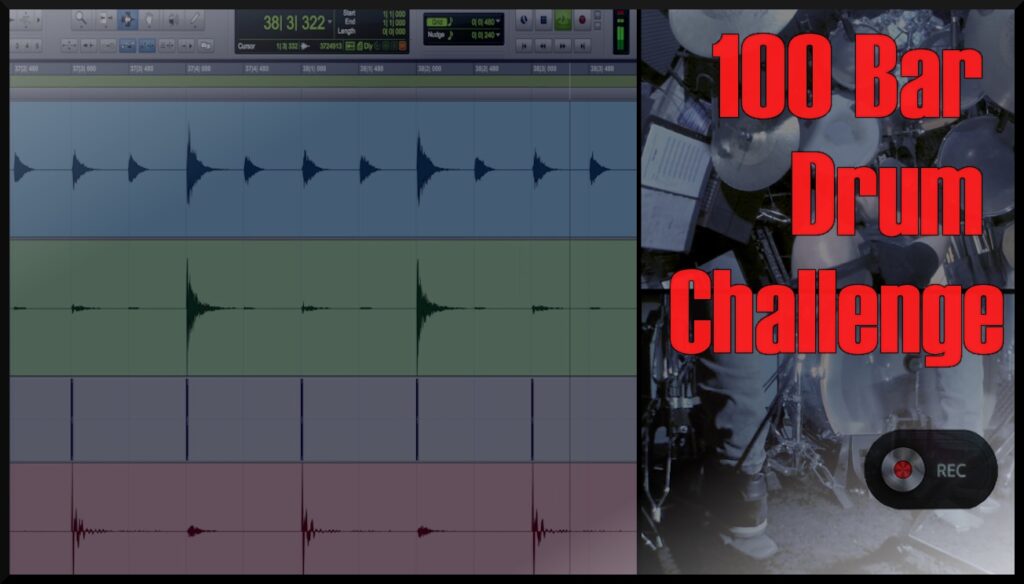Would you like to do a quick reality check? Then this is for you. The idea is really simple: record yourself playing 100 bars of the most basic drum beat, at the comfortable tempo of 100 bpm and playing along to just the metronome.
In total it’s about 4 minutes, just like the average duration of a song and the least amount of time we are required to play without missing a beat.
Ideally the goal is to bury the click the whole time, but practically it’s mostly about staying relaxed and avoiding time fluctuations and sound variations, while remaining focused on the groove and making it feel good.
Experiments like this can be humbling, and every time I try them I realize how limited I am. Yet it’s worth it because this kind of exercises are really useful to become instantly more aware of what needs to be done, and refocus our efforts and practice routine toward things that really make a difference in our playing.
If you never tried it’s likely that you underestimate how challenging this can be. That’s exactly the reason why I invite you to take this challenge: to help you prioritize your practice plan goals in an optimal way, and also to avoid you the pain of possibly missing a great opportunity because you realize that you can’t do it right in the middle of a gig or studio session.
As a matter of fact, getting along with the metronome is one of the things we need to be able to do as contemporary drummers. It’s one of the crucial skills, not only because as drummers we are the foundation of the band, but also because in today’s music scene near perfect timing is basically imperative.
However, if we are busy practicing all day 32nd note licks, and never pause and make sure we can make a basic beat groove with a metronome, it’s unlikely that we will ever work on it. By the way, as you probably heard, if you plan to become a pro drummer, being able to do this is what actually pays the bills.
I have included a GarageBand template session that you can use to practice this study. It’s already arranged with the 3 elements we need to focus on in order to verify how precise we are. 3 channels: Hi-Hat, Snare and Bass Drum, plus a great metronome sound that is nice and musical.
The tracks are purposely zoomed in a lot and big enough so that we can use the visual component as a great additional feedback tool (more on this below).
You can download it here:
Drum Challenge Session Template
And you can watch the YouTube video of me giving it a shot by clicking here, to see how this works:
Let me give you a very effective approach. The key is that it has to seem perfect even though it’s never going to be so. Then how do we do it? The answer is continuity and consistency, which are achieved through micro corrections, so let’s keep these concepts in mind as we record ourselves and listen/watch back.
By analyzing the waveform, we can notice a few important things:
- The consistency of hits placement, based on their positioning on the grid.
- How timing fluctuations and notes ahead or behind the beat look like.
- Sound consistency, based on waveform shape.
- How sound variations (like when we miss a Rim Shot for instance) look like.
As mentioned above, it doesn’t necessarily have to be perfect, so don’t go too far and become obsessed with this stuff. Computers are perfect and as we know they have no feel, which is why producers move things around by a few milliseconds to make electronic beats groove like a good drummer. What’s important is that our hits don’t flam with the click when they are not perfectly aligned to it.
The tolerance is 2 to 4 milliseconds, based on the tempo (at slow tempos there’s a bigger margin of inaccuracy before things begin to sound weird). In the video demo my biggest imperfections are about 4 or 5 milliseconds ahead or behind the click: 2 or 3 milliseconds are almost inaudible, 4 or 5 are still acceptable, anything beyond that sounds pretty ugly.
I panned the metronome to the left, so that you can also listen to the performance without it. This is another important aspect because when we make a record the click is not what the listener will hear in the final mix, so what really matters is not that we are always perfectly spot on. Instead, what matters is that our beats groove with the rest of the band and are consistent, our time feel is great and there are no evident timing fluctuations.
Again, that’s why the most effective approach is to concentrate on playing as precise as possible, while at the same time prioritizing feel over perfect accuracy, because our feel makes it into the mix while the click track doesn’t.
I strongly recommend that you try this, because in less than 5 minutes you are going to find out exactly what you need to work on. What aspects of your technique, accuracy, timing and feel you need to improve. On the other hand, if you can do it, you know that your level of control and your timing are quite good.
I find it amazing that the first beat we have all learned, which almost any person can start playing in less than 10 minutes, and that we all take for granted, is also so hard to play at this level. The reason is that, as usual, it’s not the ‘what’ that is difficult, it’s the ‘how’.
What if you discover that you are unable to play accurately with a click track? The solution is to identify whether the issue is in the physical, logical or emotional part, and then start working first of all on improving your technique and control: this Free Drum Method can set you off in the right direction.
Lastly, you can use the template I gave you to practice recording and then listening/watching back anything you are working on, thus dramatically speeding up your progress.
Related resources:
‘Click & Timing’ – Altitude Drumming – Volume 6
‘In Session – How To Sound Great On Records’




















